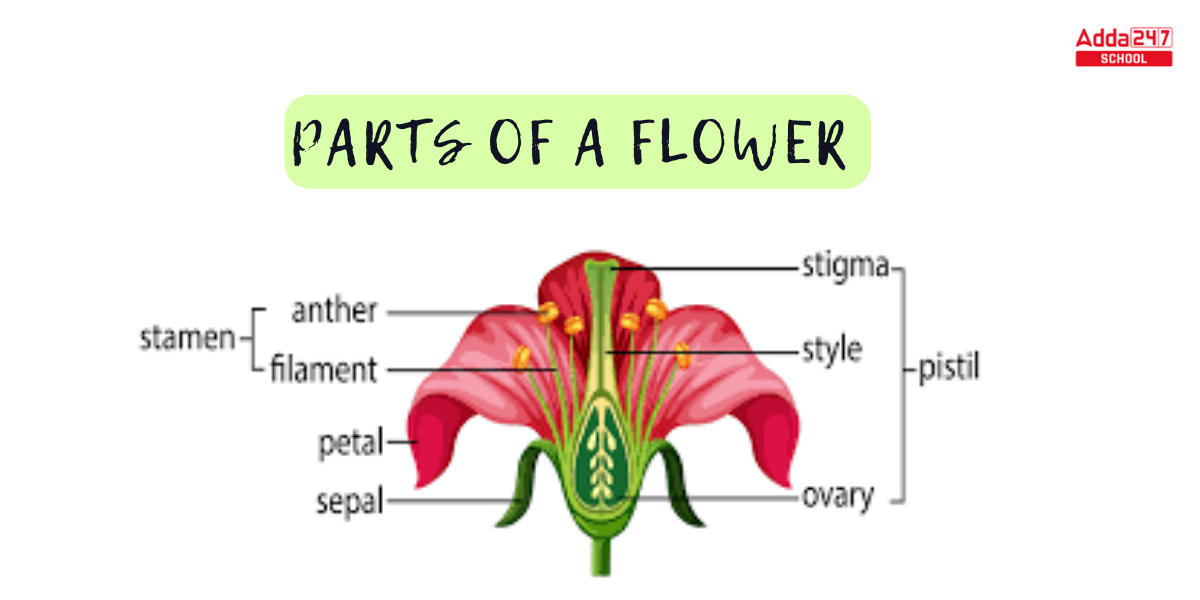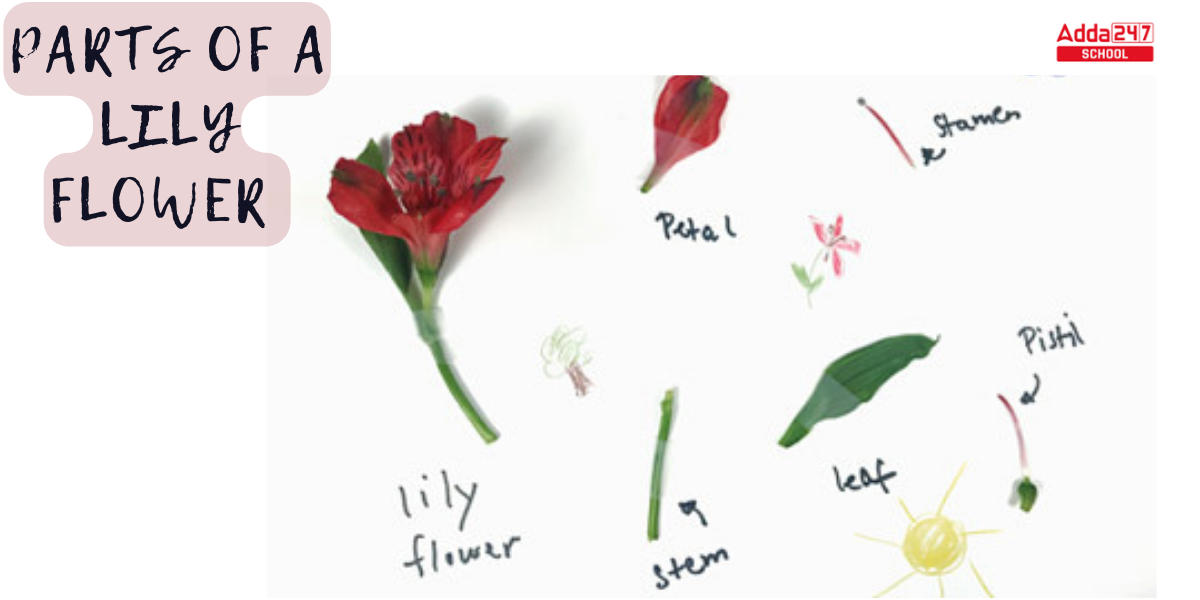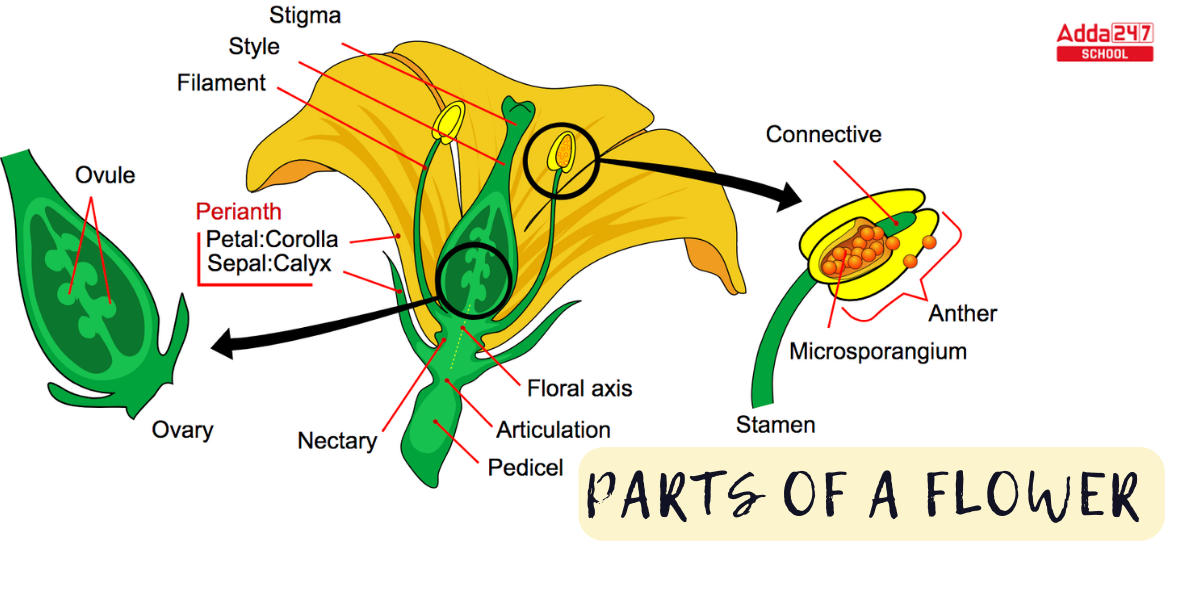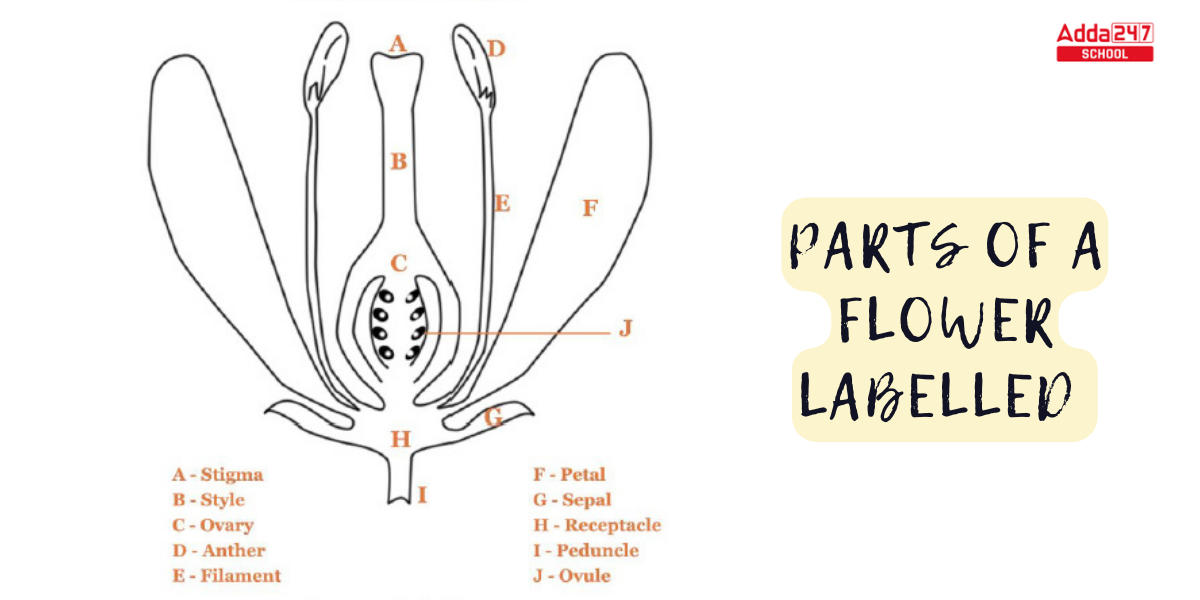Table of Contents
Parts of a Flower: Flowers hold the reproductive organs of the plant and serve primarily to facilitate sexual reproduction. We classified flowers as follows based on the parts of a flower.
- complete and incomplete,
- perfect and imperfect,
- monoecious and dioecious
However, we can separate the parts of a flower into two categories:
- vegetative and
- reproductive.
Many pollinator-dependent flowers, such as those pollinated by birds and butterflies, have developed to have vibrantly colored petals and alluring smells to draw in pollinators. In this article, we will examine several types of flowers based on parts and each parts of a flower in detail. By reading the entire article, you will be able to identify parts of a flower of your own.
Parts of a Flower Biology
Parts of a flower indirectly ensure the species’ existence. The four primary parts of a flower are sepals, petals, stamens, and carpels. The stamens are the male component of the flower, while the carpels are the female part. Generally, petals are vibrant in color and structure to attract pollinators. Wind-pollinated flowers do not need to be as showy in colour and perfume in order to live, hence wind-pollinated flowers are often less vibrant in both looks and fragrance. The majority of flowers that we found easily are hermaphrodites, meaning they have both male and female parts. Other flowers may have one of the two pieces and be either masculine or female.
Parts of a Flowering Plant
As previously pointed out the Parts of a Flower, we can divide flower parts into two categories: –
- Petal and sepal are examples of vegetative parts.
- Stamen and pistil are reproductive parts.
This stamen is further subdivided into anther, filament, and pistil into stigma, style, and ovary.
Parts of a Flower Diagram
See the graphic below for a more detailed explanation of the classification of parts of a flower.

Parts of a Flower: Complete and Incomplete Flowers
All flowers are unique based on Parts of a Flower, they have some characteristics that comprise their basic morphology. The petals, sepals, stamen, and pistil are the four primary elements of a flower.
- A flower is considered complete if it contains all four of the given key elements of a flower. Example – Hibiscus and Tulip are two examples.
- If any of these pieces – petals, sepals, stamen, and pistil – is lacking, the flower is incomplete. Corn, squash, and grass are some examples.
Parts of a Flower Class 6: Perfect and Imperfect Flowers
The stamen or the male organ and carpel/ pistil/ gynoecium/ female organ are the reproductive organs of the flower that are required for seed formation.
- A flower is called a perfect flower if it possesses both male and female components, even if it lacks some of the other essential vegetative parts. Apple, lily, orange, and carrot are among examples.
- An imperfect flower is one that has only one of the reproductive organs, either a stamen or a carpel. Squash, cucumber, corn, walnut, and chestnut are among examples.

Parts of Flower Class 6: Monoecious and Dioecious Plant
Furthermore, plants with defective flowers can be divided into two groups. There are monoecious and dioecious varieties.
Monoecious plant – On the same plant, monoecious plants produce imperfect flowers that are both male and female. This means that some flowers on the same plant will only have a healthy stamen but no carpel, while others will have a functioning carpel but no stamen. They are self-pollinating and hence capable of bearing fruit and producing seeds on their own.
Example – Oak, Pine, Spruce, and Banana are some examples.
Dioecious plant – In this type of plant the male and female reproductive organs have separate identities, implying the presence of two distinct organisms or plants. Dioecious plants contain imperfect male and female flowers on distinct plants, so one plant will display all-female imperfect flowers with carpel but no stamen, while another plant of the same species will have all-male imperfect flowers with carpel but no stamen. It requires both species to come into touch with each other in order for cross-pollination to occur.
Example – Cottonwood, plum pine, Mulberry bush, Papaya, and Date palm are examples of dioecious plants.
Parts of a Flower and Their Functions
The various parts of a flower and their functions are explored below.
Peduncle
The flower stem is known as a peduncle. We usually break this section when we pick a flower.
Receptacle
The flower’s receptacle is the section to which the stem is attached. It is little and located in the core of the flower’s base.
Sepals/ Calyx
The tiny, leaf-like components sprout at the base of the petals. The outer components of the flower that envelop a developing bud are known as sepals. The calyx is the grouping of sepals. They make up the flower’s outermost whorl. The calyx and its sepals’ primary role is to safeguard the flower before it blooms.
Petal/ Corolla
The petal layer is located slightly above the sepal layer. The petals are referred to collectively as the corolla. The parts of a flower that are frequently brightly colored. Their primary function is to attract pollinators like insects and butterflies to the bloom.

Stamens / Androecium
Stamens are the male reproductive parts of a flower. The androecium is the collection of stamens. stamen is the pollen-producing portion of a flower and is usually supported by a short thread. Stamens are grouped into two sections structurally.
Filament
the long and delicate portion that connects the anther to the flower.
Anthers
It is the stamen’s head and the portion of the stamen that produces pollen. To fertilize, pollen is delivered to the pistil or female components of the same or another flower.

Pistil / Gynoecium / Carpel
The pistil is the flower’s ovule-producing component. The female parts of a flower are formed by this. The mature ovule is a seed, and the mature ovary is a fruit. A gynoecium is a group of pistils.
Style
The stigma and the ovary are connected by a long tube-like thin stalk called the style. When pollen enters the stigma, the style begins to hollow out and creates a tube called the pollen tube, which transports pollen to the ovaries to allow fertilization.
Stigma
The uppermost component or receptive tip of carpels in a flower’s gynoecium. Pollen germinates in this region of the pistil. It serves as the pistil’s head. The stigma carries a sticky material that attracts pollen grains from various pollinators or those distributed by the wind. They are in charge of starting the fertilization process.
Ovary
The pistil’s base is formed by the ovary. Ovules are formed in the expanded basal part of the pistil.
Ovules
These are a flower’s egg cells. They are kept in the ovary. The ovules play an important role in pollination. In ideal conditions, suitable pollen reaches the stigma and then the ovary, where it fuses with the ovules. These fertilized ovules become the fruit, and the ovules produce the fruit’s seeds.
Parts of a Flower Class 5: Functions of Flower
The following are some of the most essential functions of flowers.
- The flower’s ovary develops into a seed-bearing fruit after successful fertilization.
- Flowers supply nectar to some insects and birds, which aids in pollen transport from one flower to the next.
- In flowers, gametophytes grow.
- Flowers’ most crucial function is reproduction. They contribute to the union of male and female gametes.
Flowers can encourage either self-fertilization (the union of sperms and eggs from the same flower) or cross-fertilization (the union of sperms and eggs from other flowers).



 Bihar Board 12th Result 2025 Out @ inter...
Bihar Board 12th Result 2025 Out @ inter...
 [Live Update] NTA CUET PG Answer Key 202...
[Live Update] NTA CUET PG Answer Key 202...
 UPMSP Result 2025, यूपी बो�...
UPMSP Result 2025, यूपी बो�...










